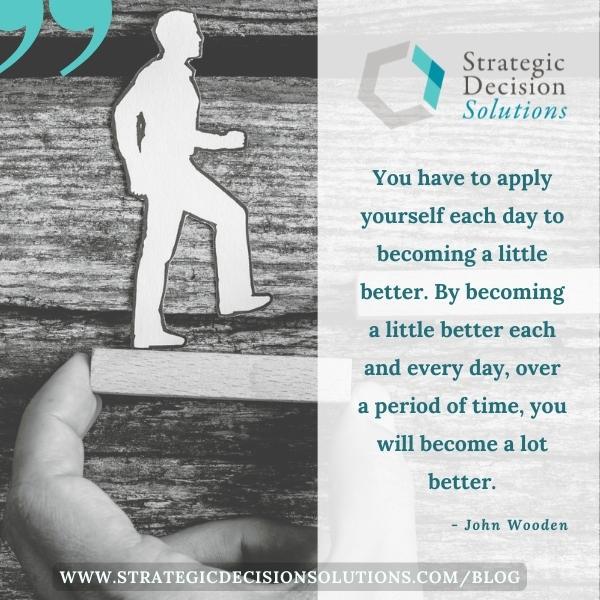To achieve success either as individuals or collectively as a group, we must resist the temptation to be stagnant and always seek improvement. A previous article where I discuss how to develop a growth mindset is one example of putting this idea into action.
Kaizen, a Japanese term that literally translates to “continuous improvement,” is another example of a mindset or concept that helps companies do this consistently. Because of its iterative nature, ERM should always be continuously improving if it is going move beyond a compliance exercise to play an active role in the company’s decision-making.
Whether you call it Kaizen or not, remaining stagnant is simply not an option in today’s volatile world.
One area within ERM where this fact is especially relevant is how the company assesses enterprise risks and opportunities.
Now I’m well familiar with the intense debate around qualitative and quantitative risk assessment methods. But as I’ve written before here, quantitative can be extremely beneficial provided the company has certain things in place first. In my experience as both an industry practitioner and later as an ERM consultant, most companies are simply not equipped to go “all-in” on quantitative risk assessment.
They have to work their way up to it, or as the Kaizen approach says, “…make small changes over a period of time to create improvements in the company.”
I previously wrote an article about one way companies can begin taking baby steps toward a quantitative approach to risk assessment, but, as I encourage everyone to constantly be learning, so do I. And what I learned is…
Despite this improvement, the final output in the form of a 1-5 rating scale is not helpful since risks are a range of possibilities and not a single point of impact.
There are no guarantees, be it in life or with risks…you can’t tell executives with a straight face that “if this risk happens, we’re going to lose X dollars.”
Executives and others need a range of likelihood and impacts, not a single point, to make truly informed decisions. Saying there’s a 75% chance of a risk causing $5 million in losses is a teeny, tiny baby step in that direction, but it provides an incomplete picture. What about the other 25% chance? Is there a 25% chance nothing happens at all or a 25% chance losses will be even more?
However, getting management and others to understand and identify ranges without having every single data point is a vexing challenge, especially when you consider that many thought leaders on quantitative assessments say you must have this level of data. This can be overwhelming for many people (and companies), leading to stagnation.
After all, probability is hard, because as Graeme Keith discusses here, it…
- Requires different parts of the brain
- Is conceptually confusing and non-intuitive
- Is so different that theorists don’t even agree on how to think about it
As Graeme explains…
Uncertain systems, by definition, respond differently every time, to the same input. The wiring we possess to subsume, integrate, and automate responses simply cannot work.”
If your company lacks experience with probability and modeling, it can be hard to give direction and overcome this challenge.
What often happens is companies will develop rating criteria and have valuable conversations around what a risk entails, its impact and likelihood, and so forth. After all of this, practitioners, managers, and others will agree the risk (…or opportunity) should be given a 3 or some other static risk score. This simple score will not be helpful to decision-makers, especially since all the context and rich information from the conversations will be lost.
So how can we start moving our company away from a 1-5 scale without it being overwhelming?
Rather than assigning a static number, lean on the experience and knowledge of managers, employees, or whomever to come up with a range of impacts. You’re not telling them, but rather providing some parameters and then letting them come up with a number based on their experience.
A manager believes a risk has a 10-25% chance of occurring, and within that range, the company could lose $10 million. On the flip side, there is a higher change of it not occurring, which means the impact could be none. This gets away from the static 2 or 4 you would see on a heatmap and provides decision-makers with a concrete impact. Don’t you think senior management would like to know both sides of the story for the risk?
Other examples include:
- We have a 10% chance of a 20% drop in our stock price and a 80% chance of a 10% drop.
- If this event happens, which we believe has a less than 20% likelihood, we could lose 30% of our workforce over the next year. However, if the event does not happen, our employee retention rate may increase by 5%.
- We believe Event X has a 70% chance of occurring, and if it does, our turnover rate could increase by 15% in the next 6 months.
- This opportunity has an 80% chance of yielding a $10 million profit and a 20% chance of resulting in a $4 million loss.
With concrete numbers like this in hand, senior management can then use risk tolerance and other tools to determine if it’s worth taking steps to reduce the chance of the risk occurring or if it’s worth pursuing the opportunity. This is where the tough decisions are made on what the company is willing and able to tolerate or go after (e.g. the best risk response).
Many insightful thought leaders like Graeme, Hans Læssøe, David Vose, and others will say an approach like this is still relying on “crystal balls and tea leaves.”
It’s important to be up front with management – while these ranges are derived from data, they are ultimately determined by a person’s experience and knowledge (which is rife with bias) and is not a math model.
It’s a baby step along the path of improved risk assessments…
While it takes persistence and determination to get quantitative approaches right, the pay off is well worth it in the long run.
Many risk practitioners become overwhelmed because they have been trained to think that ERM maturity means constantly adding fancy or more time-consuming processes like KRIs or modeling. This misconception is what often leads ERM, and the broader company for that matter, to become stagnant, which is something we want to avoid.
Instead, baby steps rather than some massive undertaking is how companies can keep moving forward. As legendary UCLA basketball coach John Wooden proclaims:

One thing is clear…
Based on risk-specific and general commentary of world trends – stagnation and simply saying “this is how we’ve always done it” is a recipe for failure in the long run.
Taking incremental steps to change methods for assessing risks is one way your company can avoid this fate without being overwhelming.
What steps are you taking to prevent risk assessment or other ERM processes from becoming stagnant?
Moving from qualitative to quantitative risk assessment methods is no easy task, which is why the “baby steps” approach is so important. To share your thoughts on this or any other ERM-related topic, please feel free to join the conversation on LinkedIn.
You can also send your comments or questions privately to comments@strategicdecisionsolutions.com.
Last but not least, if processes like this are stagnating your progress, and you’re struggling to get things unstuck, reach out to me and schedule a call to discuss your company’s specific needs and potential solutions today.








